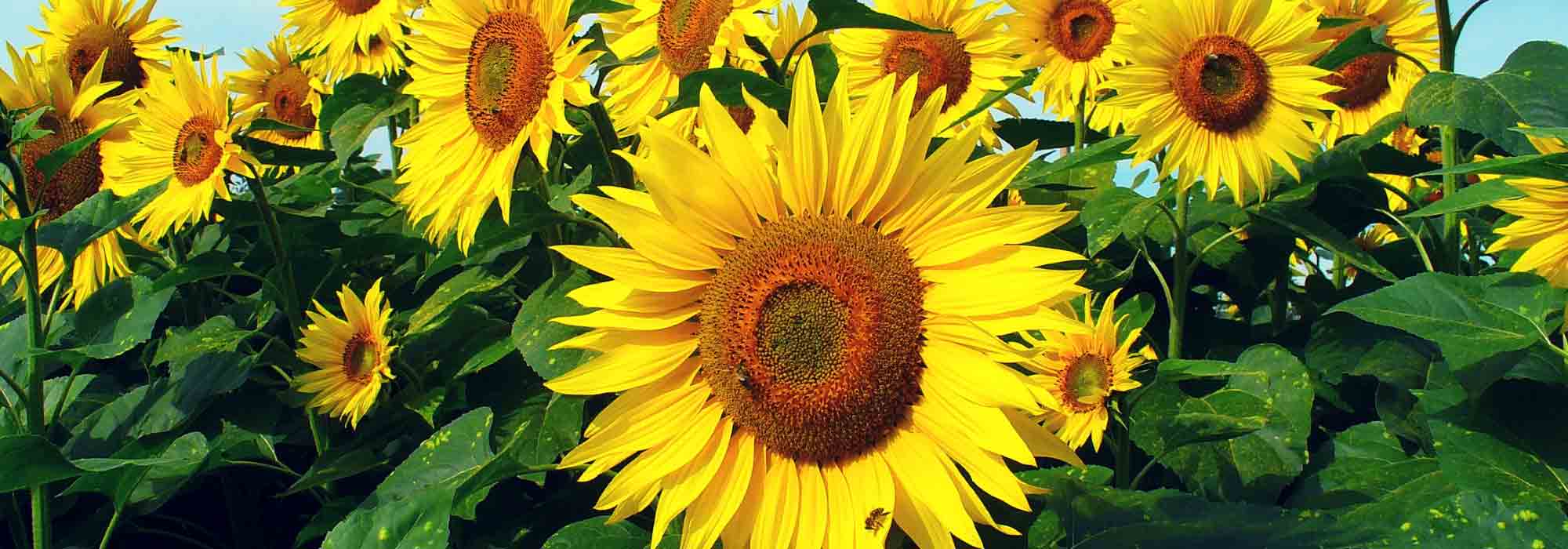
Sunflower: sowing, planting, care
Contents
Annual sunflower in a nutshell
- Sunflower is a very popular annual flower with rapid growth and can reach up to 4 m tall
- Its flowers, resembling giant daisies in warm colours, can reach 60 cm in diameter
- Easy to grow, it grows quickly in full sun in rich, cool soil
- Whether giant or dwarf, it is especially popular with children and its large seeds are edible!
- Impressive at the back of borders, it is also superb in pots or as a border plant and produces excellent cut flowers
A word from our expert
Summer’s emblematic flower, Helianthus annuus, Sunflower or “Garden Sun” is an annual plant capable of growing up to 4 m high and producing huge heads over 40 cm in diameter.
Spectacular, this flowering with the appearance of a giant daisy inevitably catches the eye throughout summer and always makes a splash in a garden. The single or double heads open from July to October, in brilliant sun‑yellow colours, most often, but also orange, brown or red.
There is no better annual plant to brighten a setting and create wonder! From dwarf Helianthus annuus to the giant sunflower, all will bring a touch of whimsy and boldness to your garden or to Van Gogh-style bouquets!
Uses of Helianthus annuus are numerous: compounds contained in sunflower seeds are useful in cosmetics and homeopathy, notably for their antioxidant properties.
Annual sunflowers like full sun, rich, fresh soil and are perfect for breaking monotony in a flower bed, a summer border or on a terrace in a large pot.
Rediscover this very popular sunflower and, thanks to our unique collection of annual sunflower seeds, impress your neighbours!
Description and botany
Botanical data
- Latin name Helianthus
- Family Asteraceae
- Common name Sunflower, Heliotropic, Sunflower, Garden Sun
- Flowering From July to October
- Height 0.30 to 4 m
- Exposure Sun
- Soil type All, fresh, well-drained
- Hardiness frost-tender
Helianthus annuus, commonly called Sunflower or “Garden Sun”, is an annual plant of family Asteraceae, native to prairies of northern, central and southern United States. Genus Helianthus includes 70 to 80 species, some perennial such as Jerusalem artichoke whose tubercles are eaten.
Annual species are most often cultivated. Helianthus annuus is the most cultivated species, notably for its oilseed seeds from which sunflower oil is extracted.
Common sunflower has undergone many horticultural and hybrid selections. It is now available in numerous cultivars, sometimes with very double, pompom-like flowers and in various colours.
There are dwarf forms with extremely short stems of about 0.40 m such as ‘Teddy Bear’, medium varieties that do not exceed 0.80–1.20 m, and giants that can surpass 3 m like ‘Russian Giant’.
From a strong taproot rises a bushy, vigorous clump composed of a robust, very ramified main stem. With rapid growth, it can reach 4 m in height within three months for tallest sunflowers.

Helianthus annuus – botanical illustration
These many erect, pubescent stems bear deciduous leaves, bristly with coarse hairs distributed alternately at base, then opposite toward stem tops. Rugose leaves 10 to 40 cm long are cordate and dentate, mid to dark green.
From this large, rough-to-touch foliage rise thick stems that branch naturally to offer from July to October a succession of inflorescences resembling large oxeye daisies gathered in a huge head. Each branch bears, depending on cultivar, a single terminal flower or several terminal flowers.
Sunflower flowering is spectacular for its opulence and gigantism.
Heads, solitary or in clusters, appear at stem tops, facing sun. They are set with a collar of oval bracts ending in a point. Naturally, sunflower flower tends to bend easily, giving impression it follows sun’s course, a phenomenon called “heliotropism“.
In reality, this is only an impression because sunflower flower does not turn: it is the stem that orients to optimise head growth, systematically toward rising sun, therefore east, to avoid sun rays impacting seeds’ seed viability. That is why sunflower flowers all face same direction, east! A peculiarity that inspired common name Sunflower (“turns with sun”) or Heliotropic.
These simple or double pompom suns can measure up to 60 cm diameter in giant varieties.
Heads are bordered by a row of large ligulate florets arranged radially around a prominent central disc brown-black or purple, sometimes tinged red. Central tubular florets form spirals. Whole resembles a celestial body of stunning solar beauty.
Helianthus annuus ‘Teddy Bear’ is notable for very double flowers, evoking large calendula, composed of petals so tightly packed they give illusion of a “ball of fur”, hence English nickname “Teddy Bear”.

Evolution of a sunflower flower
Generally of a characteristic bright golden yellow reminiscent of sun, these radiant florets also show warm tones with red shading. Orange or burnt red, mahogany or chocolate brown complete dominant yellow range. There are even suns of a lovely creamy, slightly sulphur-coloured hue. Some Garden Suns take on a bicolour aspect with ligules marked by a halo and contrasting rings, as if painted.
Annual sunflower flowers endlessly into autumn, some varieties able to produce up to a hundred flowers per plant!
This tireless flowering delights pollinating insects, bees and butterflies, which flock to these very melliferous heads.
These sunny flowers producing little pollen keep well in vase and, when size is moderate, make summer bouquets both rustic and highly pictorial in Van Gogh style.

Sunflower flowers delight foraging insects
At end of summer, after pollination, each flower produces fruits, achenes. Heads filled with seeds droop toward soil under weight of seeds which, depending on variety, are white, black or striped and much loved by birds in winter scarcity. Edible, seeds can be eaten raw or roasted; since 18th century sunflower oil with excellent dietary qualities is extracted and remains most consumed in France.
Everything is edible in sunflower: buds are delicious cooked in butter, petals with hazelnut flavour can garnish salads. Leaves provide excellent fodder for animals, stems are used in paper, textile or as thermal insulation.
Easy to grow, annual sunflower requires full sun all day long. It prefers long hot summers, so easier to cultivate in regions south of Loire. It will grow easily in rather rich, dry, deep, slightly calcareous soil that stays cool.

Giant varieties are suited to back of borders in a sunny bed where they always produce or create a temporary hedge. Dwarf sunflowers are perfect in low borders, rockeries, pots, edging or centre of beds.
Moreover, annual Sunflower is a phytoremediating plant with ability to accumulate chemical elements and is used to clean soils contaminated by radioactivity.
Main species and varieties
Helianthus annuus is the most widespread annual sunflower species (rarely encountered H.debilis). It has given rise to many interesting cultivars and hybrids, dwarf or giant, with very double or single flowers, uniflorous or multiflorous, and even varieties with very large pollen-free flowers!

Sunflower Russian Giant Seeds - Helianthus annuus
- Flowering time August to October
- Height at maturity 3 m

Sunflower Claret F1 Seeds - Helianthus annuus
- Flowering time July to November
- Height at maturity 1,50 m
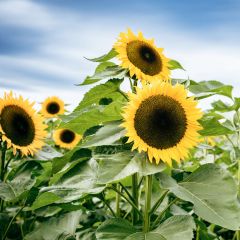
Giant Sunflower Seeds - Helianthus annuus Uniflorus Giganteus
- Flowering time August to November
- Height at maturity 2,50 m
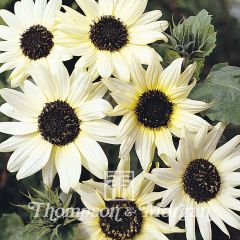
Sunflower Italian White Seeds - Helianthus annuus
- Flowering time August to October
- Height at maturity 1,50 m

Sunflower Solar Eclipse F1 Seeds - Helianthus annuus
- Flowering time August to October
- Height at maturity 1,65 m
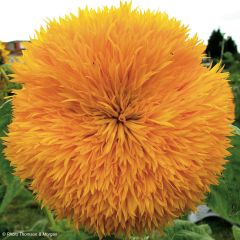
Dwarf Sunflower Teddy Bear Seeds - Helianthus annuus
- Flowering time August to November
- Height at maturity 50 cm
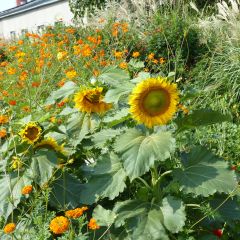
Dwarf Sunflower Sunspot Seeds - Helianthus annuus
- Flowering time August to November
- Height at maturity 40 cm
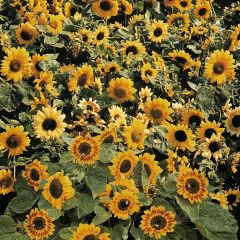
Sunflower Music Box seeds - Helianthus annuus
- Flowering time August to November
- Height at maturity 65 cm

Sunflower Prado Red seeds - Helianthus annuus
- Flowering time August to November
- Height at maturity 1,20 m
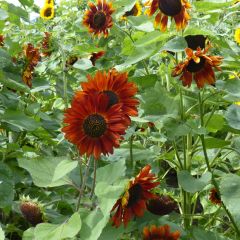
Sunflower Velvet Queen Seeds - Helianthus annuus
- Flowering time August to November
- Height at maturity 1,50 m
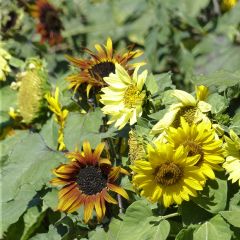
Sunflower Paquito Mix Seeds - Helianthus annuus
- Flowering time August to October
- Height at maturity 50 cm
Discover other Sunflower seeds
View all →Available in 1 sizes
Available in 1 sizes
Available in 1 sizes
Available in 1 sizes
Available in 1 sizes
Available in 1 sizes
Available in 1 sizes
Available in 1 sizes

Available in 1 sizes
Planting
Where to plant sunflowers?
Because of its frost‑sensitive character, common sunflower or Helianthus annuus is grown in our country as an annual.
Undemanding, this dazzling daisy‑like plant needs only sun to flower well! It needs long, warm summers to give its best and will grow better south of the Loire. Moreover, lack of sun will prevent seeds from reaching ripeness. A situation sheltered from strong winds that could lay down stems already weighed down by the flowers of the tallest varieties is also recommended. Staking may be necessary, especially in windy areas.
Although it will grow in any type of soil, sunflower will reach its full potential and be more floriferous in a rather fertile, well‑drained soil that remains fairly cool in summer. It dislikes waterlogged soils, so ensure your soil is well‑draining.
The annual sunflower is a boon for gardeners who want to bring abundant, fast colour to their borders throughout summer. With their large, graphic heads, the tallest add height to borders in a single season.
The spectacular flowers of giant varieties that can reach up to 4 m in height will majestically dominate other flowers, bringing structure and boldness to summer scenes. Large sunflowers make an impact when placed at the back of a border, to dress a sunny wall, or to quickly create a temporary plant screen at the foot of bushes or to define a sunny area of the garden.
With its particularly melliferous flowers, the annual sunflower also has its place in the vegetable plot, where it contributes to the pollination of plants and can serve as a natural support for beans, climbing peas or gherkins!
Dwarf annual sunflowers will liven up borders, low beds, mixed-border and summer containers.
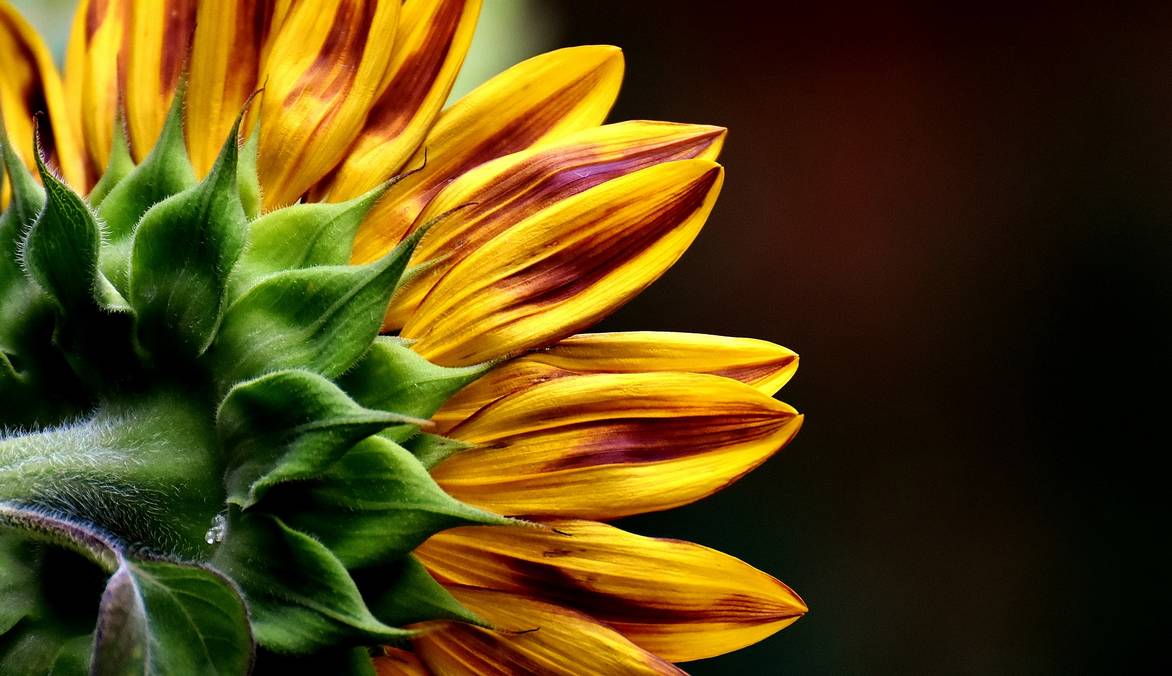
Read also
Best edible flowers for the gardenWhen to sow and how to transplant sunflowers?
When to sow annual sunflower seeds?
The annual sunflower seeds are sown in open ground from late April to mid‑June, once risk of frost has passed and soil has warmed, or from March to May under cover. Feel free to mix different varieties together to compose colourful, warm displays. If conditions are right, about 3 months will pass between sowing and the start of sunflower flowering.
How to sow annual sunflower seeds?
Their great ease of sowing, spectacular growth and large flowers make them very popular with children, who will discover joys of gardening. Don’t hesitate to sow in groups for a striking mass effect.
In open ground
Stagger sowings to extend flowering.
- Loosen soil deeply by digging and remove weed roots and stones
- Sow seeds in rows in a furrow 1–3 cm deep or in clusters, i.e. in holes with 2 or 3 seeds
- Space 20–50 cm apart
- Cover with 1 cm of potting compost
- Water regularly with a fine spray and keep moist until germination, which occurs quickly in 8–15 days
- Keep only the most vigorous young plants, at 30–40 cm intervals
Under cover
Sow annual sunflowers early in spring to plant out in open ground in May–June.
- Sow 3 or 4 annual sunflower seeds per bucket in good seed compost
- Firm down lightly and cover seeds by sprinkling with compost
- Water generously with a fine spray
- Keep these sowings moist but not waterlogged, in light but out of direct sunlight and at an ambient temperature of 20°C to 25°C
- Germination will take about 21 days
- When outdoor temperature is warm enough, plant out your young plants when they have 3–4 leaves, adding a handful of compost to each planting hole
- Respect planting distance of 45–60 cm between each young plant
Sowing annual sunflower in pots
The smallest sunflowers are superb in pots on a sunny terrace or balcony.
- In a pot at least 30 cm in diameter make a layer of gravel
- Fill with potting compost and place 3–6 annual sunflower seeds in a hole in the centre of the container
- At 3–4 leaf stage, keep only the most robust seedling
- Stake if necessary
- Water regularly during dry weather
When and how to harvest sunflower seeds?
At the end of summer, when flowers bow their heads under the weight of annual sunflower seeds, it means they, sated with sunshine, have reached ripeness. You can harvest them for eating, for future sowing or to feed birds during the cold season.
- With a knife, cut off entire heads
- Leave them to dry in a dry, well-lit place
- After a few days, rub the heads with your finger to dislodge the seeds
- Place your harvest in jars; annual sunflower seeds keep for several years while retaining their germinative qualities

Sunflower seeds
Maintenance, pruning and care
Once well established in full sun and in well-drained soil, Helianthus annuus or garden sunflower grows without needing much care.
A little attention will, however, help to prolong flowering.
While it loves sun above all, sunflower, whether in a pot or planted in the ground, is vulnerable to drought. It really needs watering regularly but always without excess, when soil is dry: never let soil dry out completely.
Mulch the base during summer to help keep soil cool.
Remove faded flowers as they appear to encourage others.
Fairly robust, stems do not normally require staking, however the tallest varieties may tend to flop in wind and, above all, under the weight of the heads which grow much heavier as seeds reach ripeness: stake if needed.
At season end, pull up clumps of your annual sunflowers.
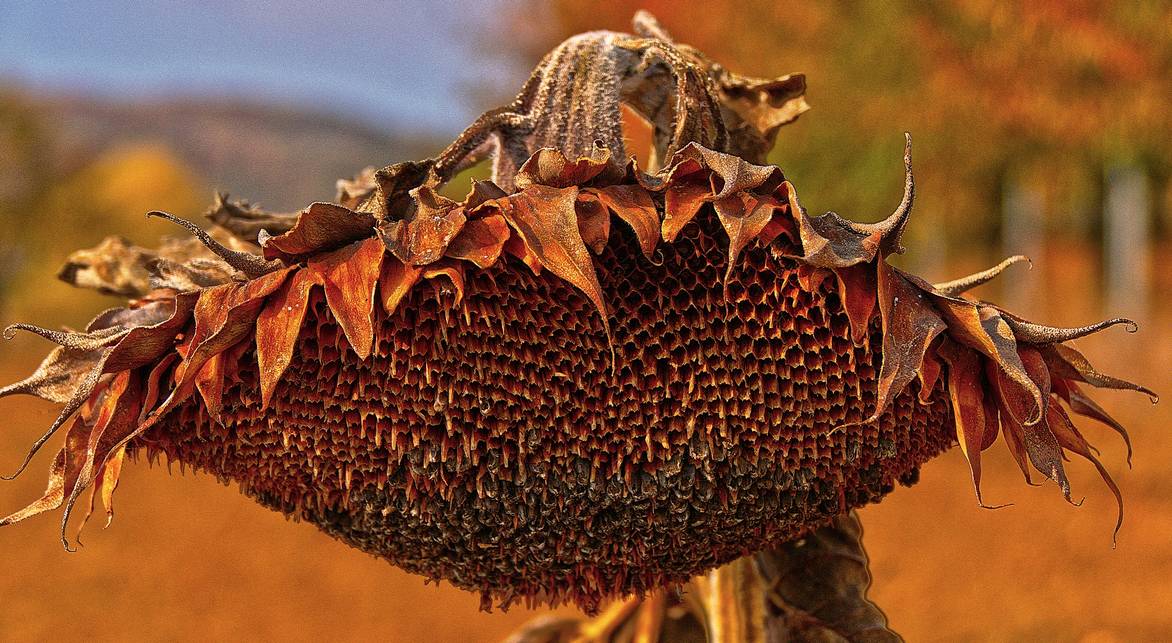
Faded sunflower flower
Possible diseases and pests
Vigorous and particularly disease‑resistant, Annual Sunflower is really only vulnerable to attacks by snails and slugs, which are fond of its young shoots. Discover our 7 ways to fight slugs effectively and naturally and how to make a slug trap.
It is less commonly targeted by aphids: sow nasturtiums near your sunflowers, this trick will divert them.
At season’s end, garden sunflowers can be susceptible to powdery mildew, which leaves a white coating on leaves. Avoid wetting foliage when watering and follow our advice to limit disease development.
Propagation
If sowing is possible with seeds of annual garden sunflower harvested in autumn from your plants, they will not produce flowers true to the parent plant. Sow in spring, following our advice above.
Companion planting with sunflowers
Le annual sunflower is inseparable from natural gardens, unpretentious spaces to which it lends a good-humoured charm and a certain boldness that can verge on tasteful eccentricity. It is an essential of yellow gardens.
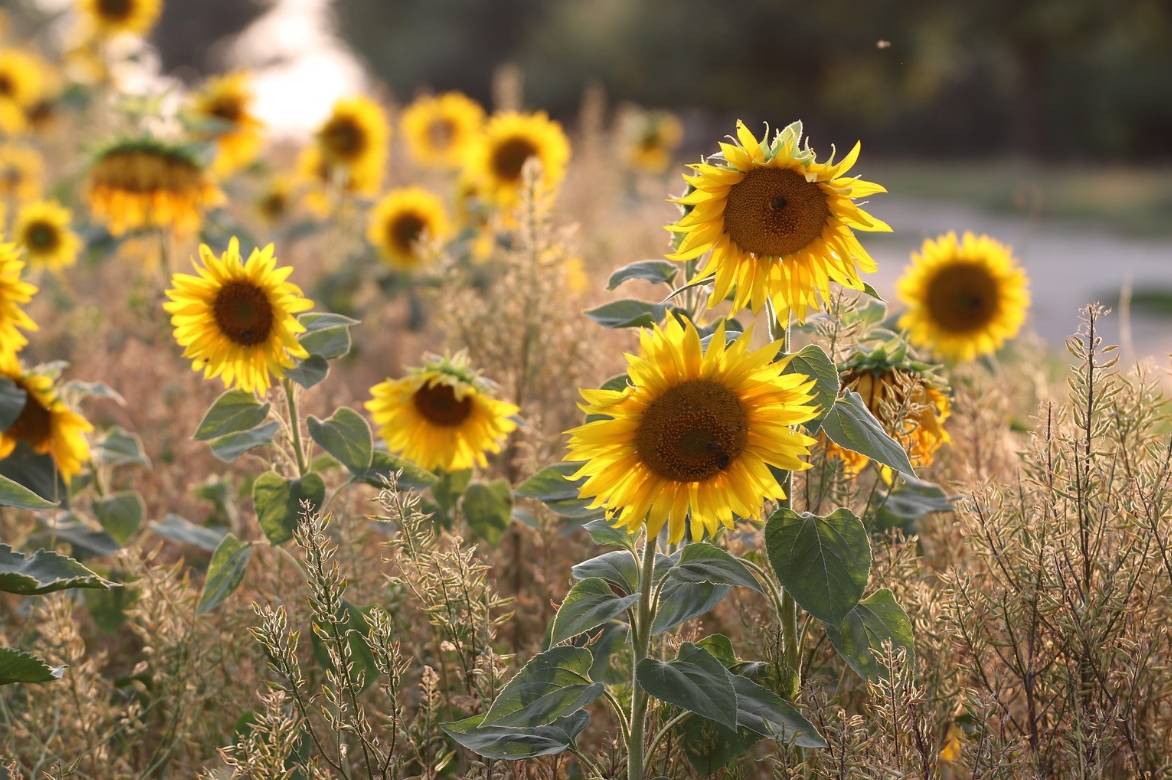
Its silhouette with often breathtaking proportions and its warm, radiant colours brighten every part of the garden and add height to all compositions.
Its sun-like flowers, large daisies, powerfully awaken every summer scene. Medium and more compact varieties are perfect for creating colourful blocks in borders.
To flower a sunny spot quickly, surround sunflowers with perennials flowering in summer or later, such as Oriental poppies, daisies, chrysanthemums and sedums. Annuals such as Nigella and cosmos will complete this abundant picture.
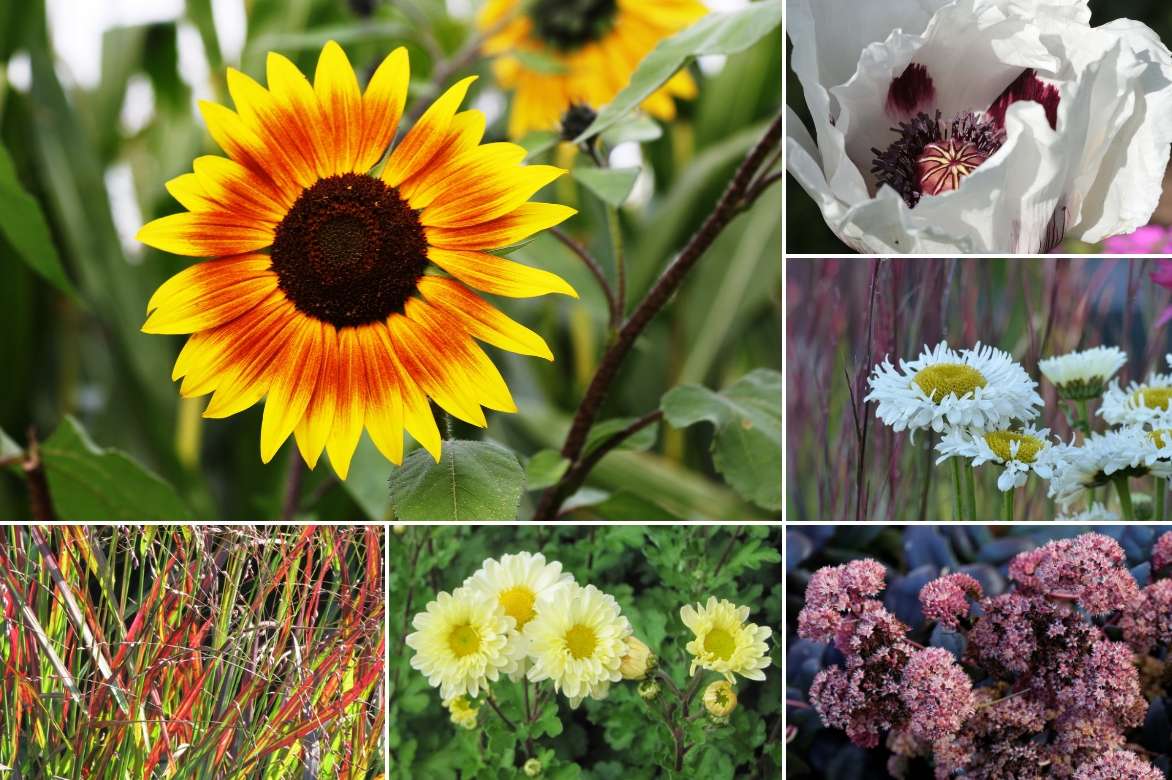
An example of pairing: Helianthus annuus (a mix of several colours such as ‘Music Box’ would be perfect), Papaver orientale ‘Perry’s White’, Leucanthemum superbum ‘Real Neat’, Sedum ‘Purple Emperor’, Chrysanthemum indicum ‘Poesie’, Panicum virgatum ‘Shenandoah’ (photo Peganum-Flickr)
The strongly defined flowers of sunflowers introduce bold accents into a bed. Airy grasses such as large Miscanthus or Pennisetums will counterbalance their architectural habit by bringing softness, movement and lightness to a naturalistic scene.
Sunflower blooms will dazzle while grasses calm the blaze a little and hide stems that quickly become rather unsightly as summer progresses.
In a red garden or a Catalan-inspired bed with fiery tones, or in a warm-themed scheme, surround annual sunflowers with tall cannas, but also copper Helenium, Echinacea in spicy shades, Kniphofia or Achillea.
Rely on the warmth and vibrancy of annual sunflowers’ colours to give character to a joyful summer border or to dress the base of a hedge made up of cosmos, annual Rudbeckia, bidens, showy tithonia, Coreopsis or daylilies.
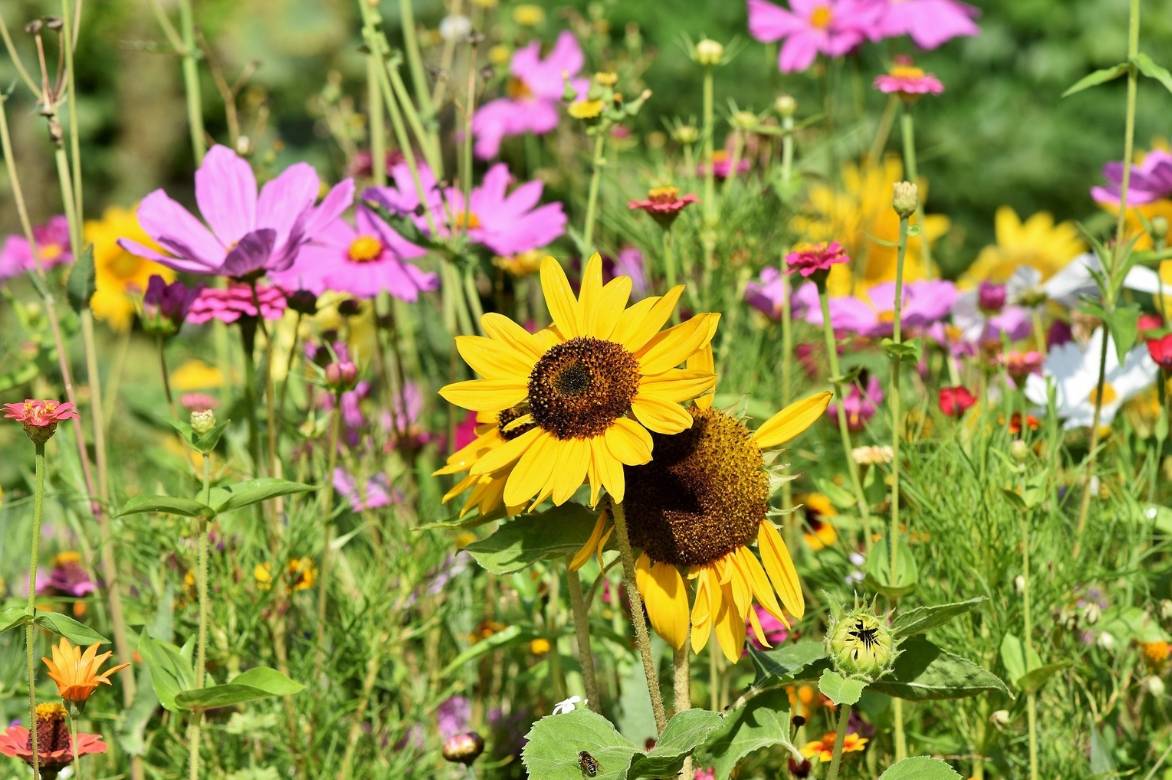
An example of pairing: a dwarf sunflower such as Helianthus ‘Solar Flash’, cosmos mix and zinnia
They are perfect in blue/yellow colour schemes. Placed at the back of a bed, yellow sunflowers contrast sharply with the blue or purple of the glaucous foliage of fescues, Eryngium, blue wheat and the flowers of large mealy sages, asters, ceanothus or the slender Buenos Aires verbena.
In the vegetable garden, invite dahlias and nasturtiums to keep them company.
Useful resources
- Fancy sunflowers? How to tone down yellow flowers in the garden?
- Flowers in the vegetable garden? Sow annual sunflower seeds!
- Dare contrasting orange/purple combinations orange/purple, pair orange sunflower flowers with azure flowers!
- Discover Ingrid’s advice for planting giant sunflowers
- Subscribe!
- Contents
































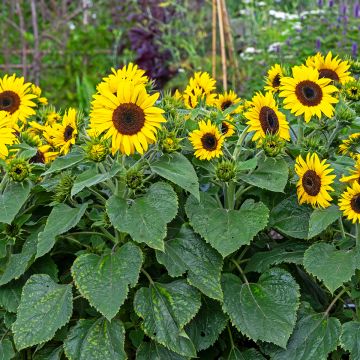

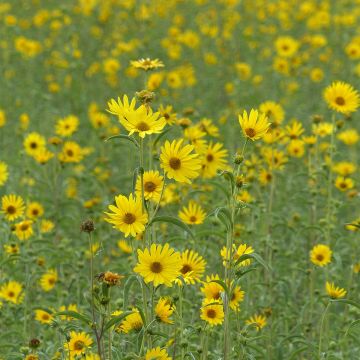
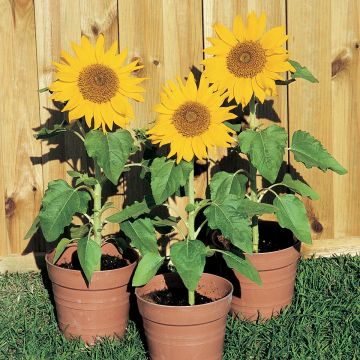
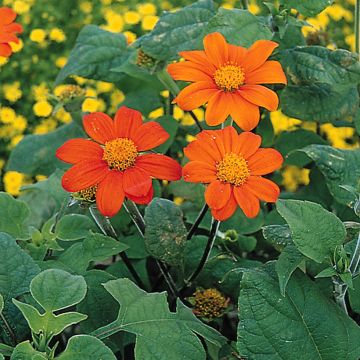

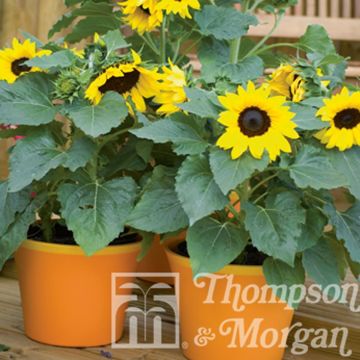

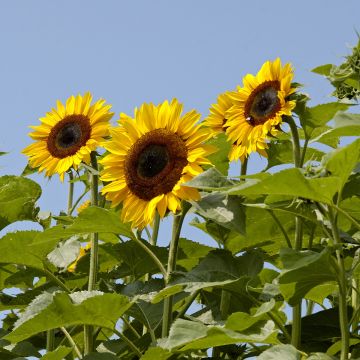
Comments